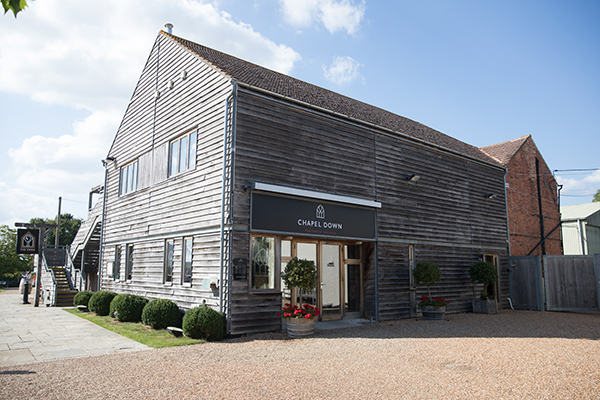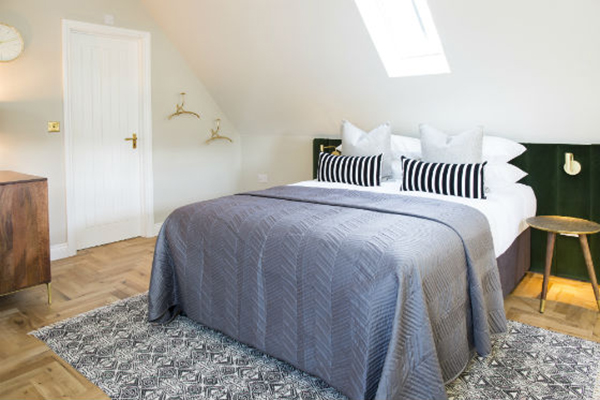The Wine Garden of England
For centuries England has remained in the shadows when it comes to wine production, but recently, Kent has been a tour de force when it comes to all things grapes. Fiona Sims reports
The sun blazes down on the terrace as Sunday brunch diners sink their teeth into salt and pepper squid hirata buns, served with a slick of chilli mayonnaise and pickled vegetables, and washed down with a glass of fizz. There are vines as far as the eye can see, fat grapes hanging heavily as leaves shimmered in the summer breeze. You would be forgiven for thinking you are in Napa, California, but this is Westerham in Kent, at the Squerryes Estate.
In case you hadn't noticed, great swathes of vineyards are being planted in the Garden of England, as Kent is traditionally known. Drive down the M20 today and it's grapes growing on all those south-facing chalky slopes, and lots of them. Thanks to its eastern location, Kent gets more sunshine and higher temperatures than most of the UK, which helps to explain why grapes are the crop de jour here. In fact, according to recent stats from Wine GB, the south-east now accounts for 75% of all plantings in the country. Add to that the best year ever after a long hot summer and a record harvest, and it's high fives all round.
A growing market
The output of the UK wine industry might still be small fry compared with other wine-producing counties (think Oregon in the US for a comparative size), which makes allocations for the good stuff often hard to come by. But it has come a long way fast since the first commercial vineyard was planted in Hampshire in 1952, winning high-profile awards and trophies mainly for its sparkling wines, and fuelling some serious investment in land.
Perhaps surprisingly, some of that investment is coming from France. From the Champagne region, Vranken-Pommery launched its debut release last year in partnership with Hampshire's Hattingley Valley, and Taittinger is busy establishing its vineyard near Faversham in Kent with UK partners Hatch Mansfield, called Domaine Evremond. The future is bright, particularly so in Kent, and the wine-loving public want a piece of the action.

The magnificent seven

All roads lead to Chapel Down, Englandâs largest wine producer. It makes the most noise, and boasts arguably Britainâs smartest winery restaurant, the Swan, with its 80 seats and first-floor terrace that looks out over the vines and the Weald beyond.
Chapel Down has been undergoing a rapid expansion programme of late. With 70,000 visitors per year, it now sports a swanky new deli packed with Kent produce and a chic new tasting room, called the Wine Sanctuary.
âWeâre not trying to increase visitor numbers, just improve the offering,â says head winemaker Josh Donaghay-Spire. Wine production, though, will increase dramatically. Currently it produces 800,000 bottles â" six different sparkling wines and a number of still wines, but fizz will become more the focus in the coming years, reports Donaghay-Spire. âThe target is 2.5 million bottles,â he reveals, as we sweep past shiny new tanks and presses.
âWeâve only been in the US for a year and a half, but we could sell twice the volume there now,â he says. âAnd remember this is not about a new wine from an existing producer, itâs an entirely new viticultural region being born and thatâs exciting. Itâs the new, New World, and to be a part of that is humbling.â
Thereâs no mistaking the ambition at Hush Heath. The 400-acre family-owned wine estate, founded in Staplehurst in 2002, unveiled a major expansion programme at the end of September that will double the size of the previous facilities, with a new shop, an upstairs terrace bar (for serving platters), and a 200-seater tasting room called the View.
Over the next five years, wine production will increase to 500,000 bottles, confirms owner Richard Balfour-Lynn, who is no stranger to building English brands, from Hotel du Vin to Liberty, and whose company also owns a number of Kent pubs, from the nearby Goudhurst Inn and Tickled Trout to newcomer the Ship in Rye. âAnd we are now selling in 28 states across the US,â he reports, showing off the wineryâs new home.
Gusbourne would agree. Its sleek new visitor centre, called the Nest, is already receiving increasing numbers of wine tourists, located just 15 miles from the medieval coastal town of Rye. Since Conservative tycoon Lord Ashcroft came on board as a majority shareholder in 2013, the business has expanded substantially, taking its vineyard tally, which is organic in its approach, up to 90 hectares.
Running faster than most is Charles and Ruth Simpson of Simpsons Estate. Their first fizz has not yet been released, but the winery has already opened its doors, complete with the wine worldâs first helter-skelter, which deposits you â" with a whoop and a grin â" from tasting room to winery in a matter of seconds.
Located in the picturesque village of Barham, Simpsons currently only has one still wine to sell, Roman Road Chardonnay â" but what a wine, with its impressively rich and creamy fruit. The pair also boasts some of the most experienced wine business credentials in the industry, as they already own an estate in the Languedoc, Domaine Sainte Rose.
With stomachs rumbling, the Simpsons directed us down the road to the Fordwich Arms in the tiny, well-preserved Kent village of the same name, just three miles east of Canterbury, which lists its Chardonnay. The transformed boozer opened only a year ago, by ex-Clove Club chef and sommelier Daniel Smith and Guy Palmer-Brown, and picked up its first Michelin star last year, putting the restaurant â" and Kent â" on the map for foodies, who now flock here for both the food and the wines.
A meal here invariably starts with a glass of its most popular fizz â" 2013 Gusbourne Blanc de Blancs, which pairs beautifully with dishes such as scallops, peas, gooseberries and charcoal cream. âIt outsells Champagne by a long way,â reports Palmer-Brown. âIn fact, for every 40 bottles of Gusbourne, we sell just five bottles of Champagne,â he says, explaining that the business made a conscious decision not to offer Champagne by the glass, only English fizz. âYes, we get the occasional grumble, but I can count on one hand those people who have complained.â Palmer-Brown would list more Kent wines if he could, but allocations are still hard to come by â" a problem that should ease after this yearâs plentiful harvest.
âYes, English wine will always be a premium product sold at premium prices â" and to be honest, when we opened a year ago, I never thought we would sell as much English wine as we do, but our customers â" many of whom come from London â" are happy to pay those premiums. I reckon that the day when people come in and just order English wine throughout the meal is nearer than you think,â he predicts. Watch this space.
The West House finds itself on the wine trail
Halfway along the high street of the sleepy black-and-white timbered Kent village of Biddenden, youâll find the Garrett familyâs jewel of a restaurant, the West House. Last year they added bedrooms to the business, housed in a newly built annex out the back. âYes, weâre getting a lot of diners who are also visiting wineries, especially at the weekend,â says chef-owner Graham Garrett, who has held a Michelin star at the restaurant for the last 16 years.
âWhen we first opened, English wine wasnât up to much â" but now look at it,â says the 80s rock-star-turned chef. âOur customers regularly ask us about English wines â" indeed we now have a special section dedicated to them,â continues Garrett, who confirms that the increase in wine tourism was indeed a big consideration when the family decided to invest in the accommodation, which cost in excess of £300,000. Now guests can stay after dinner in four quirkily designed rooms, which opened last January, starting at £340 for dinner, bed and breakfast.
Local design company, the Insider, created the interiors with a little direction from Garrett. âThis is my favourite room,â grins the chef, showing off âRock âNâ Rollâ, with its black four-poster, large hot tub on the private terrace and big name rock God artworks (including a Ronnie Wood) that pays tasteful homage to the music genre.
The Kent wine house pour, which is served by Garrettâs wine-savvy son Jake, is Davenport Vineyardâs Horsmonden Dry White, an aromatic blend of Ortega, Bacchus, Huxelrebe (available from lescaves.co.uk, and on the West House wine list at £29). âThe wine sells itself,â says the chef.
The winery at the gateway to the Wine Garden of England
Just a 10-minute drive from the outer reaches of greater London, and within rumbling distance of the M25, youâll find the Squerryes Estate, with its smart weatherboarding, tastefully converted oast house and temperature-controlled cellar. Soon there will be a winery, too (currently the wines are made by Henners nearby). âThatâs the next phase of development,â explains owner Henry Warde.
Set in 2,500 acres, with its formal gardens, vineyards, woodlands and mix of arable and dairy farms, it has been in the Warde family since 1731. The house itself, Squerryes Court, just a couple of miles down the road, was built in 1681 and remains largely unchanged.
When a Champagne house came sniffing back in 2004, talking of perfect conditions and partnerships, they decided to go it alone, planting 35 acres in 2006. âTheir confidence gave us the confidence,â he shrugs, pouring out samples of his sparkling wines to taste, a blend of Chardonnay, Pinot Noir and Pinot Meunier.
A tasting room and shop is open to the public, located in the same building occupied by the Westerham Brewery, which rents the space from them. Consequently it throngs at the weekends with craft beer drinkers, who might also take home a bottle or two of fizz. Thereâs a deli and farm shop on site, too, called Flint & Oak, showing off Kent produce, and during the summer months there is seafood tapas and Sunday brunch served on a large terrace overlooking the vines.
âWe are at the gateway to the Wine Garden of England, so we wanted an artisanal hub in which to present our wines to the world,â says Warde. âBut even though we planted the vines 12 years ago, we still feel like we are just at the beginning of our journey.â

























